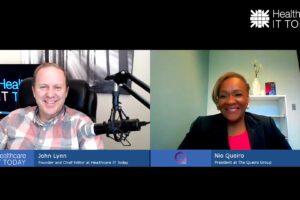The following is a guest article by Dan Mirsky, Vice President of IT, and Benjamin Walling, Vice President of Intelligence at Sage Dental.

 Historically, experts have argued that dentistry lagged 10 years behind the medical industry in terms of adoption of cutting-edge technology such as electronic patient records, practice management solutions, patient portals, etc. However, for many standout dental practices, that simply is no longer the case. Many leaders in the dental field are evolving rapidly and are now on equal ground with the standard medical practice, but in some cases are even embracing and leveraging technology solutions faster than the medical field can. For patients and providers alike, this digital transformation is exciting because it offers unmatched benefits, from convenience to cost savings.
Historically, experts have argued that dentistry lagged 10 years behind the medical industry in terms of adoption of cutting-edge technology such as electronic patient records, practice management solutions, patient portals, etc. However, for many standout dental practices, that simply is no longer the case. Many leaders in the dental field are evolving rapidly and are now on equal ground with the standard medical practice, but in some cases are even embracing and leveraging technology solutions faster than the medical field can. For patients and providers alike, this digital transformation is exciting because it offers unmatched benefits, from convenience to cost savings.
On Equal Ground
Dental leaders who are committed to technological innovation have caught up to the standard medical practice in crucial ways already, but especially in their use of data management solutions both in and out of the exam room. Modern dental practices are avid users of digital dental records, as they give practitioners easy access to patients’ dental history and previous scans, and they can quickly take notes during exams on tablets or smartphones. The front desk is plugged into these platforms as well, enabling them to follow up with patients for additional treatment, schedule appointments and otherwise automate communication, billing, record sharing and CRM strategies – capabilities that are common in medical practices today. These adoptions bring patients, providers and administrative staff increased efficiency, which means clinicians can spend more time with patients, and patient histories are more accessible and reliable going forward.
Surpassing the Medical Field
In important ways, dental leaders, like Sage Dental, have fully integrated technology that goes beyond the norm in the medical field. Technology including AI-supported diagnostics, remote monitoring, accurate billing estimates and robust cybersecurity strategies are not only improving dental patients’ experiences, but helping dental providers deliver more consistent, safer care.
- Diagnostics: It has been said that if a patient goes to 20 dentists, that patient is likely to get 20 different diagnoses. While some professional disagreement is to be expected, leaders in dentistry are striving to combat significant inconsistencies in diagnosis. One way to do this is by leveraging AI-support tools to improve diagnostic accuracy, which researchers have found can improve diagnosis by 95%. While still new, these tools are being rolled out at cutting edge dental practices and are helping dentists start more valuable, productive conversations with patients.
- Remote monitoring: Like telehealth, teledentistry has exploded during the pandemic. While it may seem counterintuitive in an industry where patients need to be seen face-to-face for treatment, there are strong use cases for virtual dental visits. Most importantly, these virtual visits allow for monitoring orthodonture progress. Patients need regular check-ins to confirm teeth are aligning correctly and confirm when the next adjustment should be made, but these appointments can be done remotely. This can cut in-office appointments down from an average of 22 to less than eight – a huge time and cost savings for patients and parents. Other applications include screening for dental issues to determine if emergency care might be needed, which has been a valuable capability during the pandemic.
- Billing: Billing can be frustrating for patients, because, similar to the medical field, patients often have no idea what they will be expected to pay until after they have received care. If initial estimates are provided, they have an alarming habit of being highly inaccurate. Sage Dental is one example of a practice that has developed an in-house platform to improve billing accuracy. The solution synthesize thousands of contracts and aggregates huge data sets to create an intelligent engine that has increased billing estimate accuracy from about 47% to over 90%. This has helped increase patient satisfaction and retention.
- Cybersecurity: Incidences of ransomware and cyber threats are increasing, with many medical practices experiencing attacks this year. Dental leaders are tackling this problem head on and are levering techniques to combat the issue which include end-user awareness, filtering systems and fake-phishing email practice drills.
With these rapid and successful technology adoptions, the dental field’s reputation is shifting. DSO and private practices alike have recognized the gaps in care quality between dentistry and the greater medical field and swiftly filled those in. With leaders keenly focused on ways to continue that digital transformation, an industry that was lagging behind medical practices is now surging ahead. As these standout dental practices have illustrated, it’s never too soon to make updates and grow out of the “underdog,” “behind-the-times” persona. Patients are closely comparing their medical and dental experiences, so technology that is adopted in the exam room is expected chairside, too. The most successful dental (and medical) practices will keep tabs on the latest technology positively impacting patients’ care and quickly adopt it as well.













